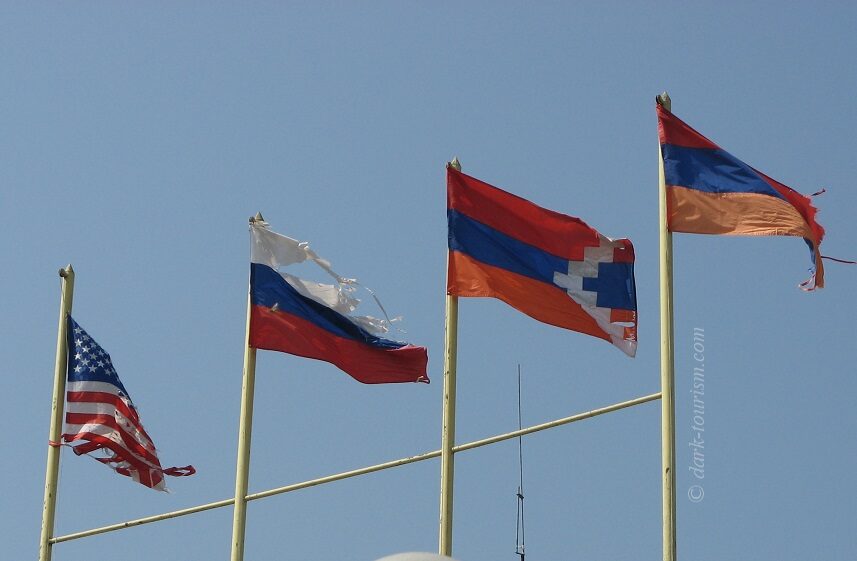| |
Into a Volcano, out of Artsakh
Hello subscribers – and welcome new ones! The title of this Newsletter is a reference to two new DT Blog posts. The first of these, uploaded last week, is the one that was promised at the bottom of the previous general Iceland Blog post, about something extra special that hence deserved its own stand-alone Blog post. Here it is now. It’s about a unique activity offered in the middle of the Reykjanes Peninsula in Iceland, called “Inside the Volcano”. And indeed: it’s a tour down the crater of the dormant Þrihnukagigur volcano – or rather into its drained magma chamber underneath the crater. It was discovered in the 1970s and in 2015 it was made accessible to tourists. For that purpose a crane has been placed horizontally above the crater opening and a lift cage attached to this then takes you down the 120m to the bottom of the enormous volcanic cavern. Apparently it’s a one of a kind in the world and the experience really is beyond words. It’s a bit of an adventure and not cheap (what is in Iceland?), but well worth it. The colours of the rocks and lava remnants down there are amazing, totally psychedelic. So do go and take a look!
The other new Blog post, uploaded the day before yesterday, is about something altogether more tragic. Azerbaijan has, by military force, taken control of the breakaway Republic of Artsakh, better known in the rest of the world as Nagorno-Karabakh. This territory, traditionally inhabited by ethnic Armenians, declared itself independent in 1994 after years of war between Armenia and Azerbaijan following the break-up of the USSR. For almost three decades this self-rule, with support from Armenia, held. Then in 2020 Azerbaijan launched its first renewed military campaign, in which it regained the former “buffer zone” around Artsakh as well as the town of Shushi, all with support and hi-tech weaponry supplied by Turkey, Armenia’s old arch-enemy to the west. A Russian-brokered “peace deal” then cemented Azerbaijan’s territorial gains but left the rest of Artsakh as it was … except that for ten months prior to the latest military aggression last week Azerbaijani military blocked the only overland supply route from Armenia to Artsakh, effectively putting the territory under siege, starving its inhabitants out. Thus weakened and in the face of Azeri military superiority, the Artsakh leadership then agreed to another ceasefire deal, one which basically amounts to surrender. Neither Armenia nor the Russian “peacekeepers” stationed in the disputed territory in the wake of the 2020 deal did much to help the people of Artsakh. On the contrary, the Russian soldiers helped in the “evacuation” of civilians, which effectively amounts to assisting in the ethnic cleansing that Azerbaijan is ultimately after. The people of Artsakh have little faith in the possibility of a peaceful coexistence with the Azerbaijanis (and they have good reasons for this lack of trust). So they are currently giving up their homeland and fleeing to Armenia in their thousands. It’s a huge humanitarian tragedy and the signal it sends (namely that authoritarianism and military aggression pay off) is more than disturbing. Also that the rest of the world has basically been looking on, or rather looking away. Not only Russia, which is obviously distracted by its war in Ukraine, but also the USA and Europe. Artsakh is probably just too insignificant and has no economic bargaining chips. So it’s been given up. Moral grounds alone don’t seem to count. It’s heartbreaking. And from the perspective of dark tourism, the fall of Nagorno-Karabakh is also a very sad loss. Even if it becomes visitable again at all, it simply won’t be the same any more. Its uniqueness is gone. So the new Blog post about Artsakh is a bit nostalgic, featuring photos from my trip there back in 2010. Several of the individual sites covered will disappear, some probably already have. The photo above is also one I took there in 2010. It suddenly has taken on symbolic meaning. The four flags are those of Armenia on the right, then Artsakh plus Russia and the USA on the left – the latter two in particular look semi-shredded and torn. In tatters. As is Nagorno-Karabakh and its international relations.
|
|
